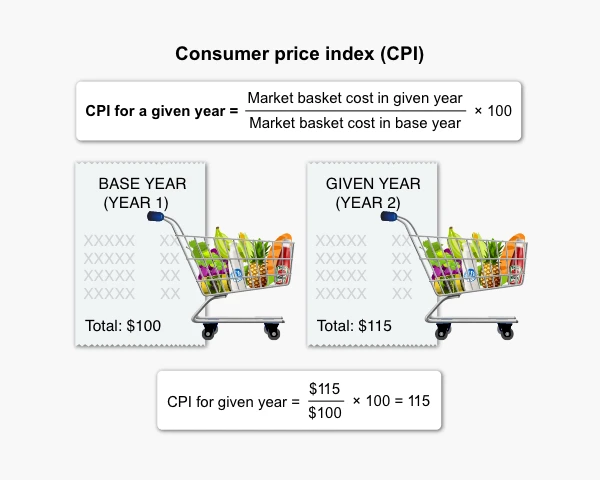Familiarizing yourself with the AP Macro exam format helps you strategize your preparation, manage time effectively across sections, and leave room to review your answers at the end.
Format of the AP Macroeconomics Exam 2025
The AP Macroeconomics exam is 2 hours and 10 minutes long and divided into two sections: multiple-choice and free-response.
How many questions are on the AP Macroeconomics exam?
Section I comprises 60 MCQs, and section II includes 3 FRQs (1 long FRQ and 2 short FRQs). You'll get 1 hour and 10 minutes to complete Section I and 1 hour (including a 10-minute reading period) to complete Section II.
Check out the table below to glance over the AP Macro exam length, structure and weight of each section:
| AP Macroeconomics Exam Structure | |||||
|---|---|---|---|---|---|
| Section | Question Type | Time per Section | No. of Questions | Exam Weighting | |
| Section I (MCQ) | Multiple-choice | 1 hr 10 mins | 60 | 66 % | |
| Section II (FRQ) | Long Free Response | 1 hr | 1 | 50 % | 33 % |
| Short Free Response | 2 | 50 % | |||
| Total | 2 hrs 10 mins | 63 | 100% | ||
Now that we've introduced the general AP Macro exam format, let's learn about each section's specifics, like the question types and the skills evaluated.

Types of Questions on the AP Macroeconomics Exam
As you may already know, the AP Macroeconomics exam structure includes two broad questions: MCQs and FRQs. First, let's start with the MCQs:
Section I: Multiple-Choice Questions
60 Questions | 1 Hour and 10 Minutes | 66% of Exam Score
Section I consists of 60 MCQs, giving you 1 minute/question plus 10 minutes to review. This section covers all six units of the AP Macroeconomics course, each holding a specific weight. This means you’ll only get a specific number of questions from each unit. Below is the list of AP Macro course units, their weight in the MCQ section, and the approximate number of questions you’ll get from each unit:
| Units | Exam Weight | No. of questions in Section I |
|---|---|---|
| Unit 1: Basic Economic Concepts | 5–10% | 3 - 6 |
| Unit 2: Economic Indicators and the Business Cycle | 12–17% | 7 - 10 |
| Unit 3: National Income and Price Determination | 17–27% | 10 - 16 |
| Unit 4: Financial Sector | 18–23% | 11 - 14 |
| Unit 5: Long-Run Consequences of Stabilization Policies | 20–30% | 12 - 18 |
| Unit 6: Open Economy—International Trade and Finance | 10–13% | 6 - 8 |
Although you'll see more questions from units 4 and 5, spending time on units 1 and 2 will establish the fundamental concepts used in economic studies. In addition to the course units, you'll be tested on three core skill categories in Section I:
- Principles and Models (30 ﹣ 40%)
- Interpretation (25 ﹣32%)
- Manipulation (30 ﹣40%)
Our step-by-step guide on how to approach AP Macro Multiple-Choice Questions will help you ace this section.
Section II: Free-Response Questions
3 Questions | 1 Hour | 33% of Exam Score
Section II of the AP Macro exam consists of 2 short FRQs and 1 long FRQ, with a 10-minute "reading
period” and a 50-minute "writing period." Reading the prompt thoroughly is key to acing this section, so the College Board® recommends spending 10 minutes reading each prompt. You can allocate 20 minutes for the long FRQ and 15 minutes for each short FRQ.
Each FRQ will test students on specific course skills The FRQ section carries 33% of the overall exam weight, with each short FRQ carrying 25% of the Section II score weight and the long FRQ carrying 50% of the section score. Section II questions require students to:
- Explain economic ideas, principles, models, results, and/or effects, making claims about them.
- Perform a numerical analysis of your claims, creating graphs or visual representations.
Need help with this section? Check out our expert guide on how to answer AP Macroeconomics Free Response Questions.
Now that you've learned everything about the AP Macro exam length and format, you need to remember it while charting your study plan. You can also use it while timing your practice tests. Repeated practice tests will help you manage time effectively across each question and section. Optimize your exam prep with UWorld’s AP Macroeconomics course, which comes with a comprehensive study guide and an extensive QBank. Simplify complex topics and boost your confidence to ace the exam! Good luck!
Starting in 2025, the AP Macroeconomics exam will adopt a hybrid-digital format. The MCQ section will be completed using the Bluebook testing app, while the FRQ section will remain paper-based, similar to previous exams.

References
- AP Macroeconomics Exam – AP Central | College Board. (n.d.). apcentral.collegeboard.org. Retrieved December 6, 2024 https://apcentral.collegeboard.org/courses/ap-macroeconomics/exam
- AP Macroeconomics Course and Exam Description. (2022). apcentral.collegeboard.org. Retrieved December 6, 2024, from https://apcentral.collegeboard.org/media/pdf/ap-macroeconomics-course-and-exam-description.pdf
Read More About the AP Macroeconomics Exam
Going through the College Board's 200-page CED can be time-intensive. Here is an easy-to-understand AP Macroeconomics course and exam description to ease your exam prep.
AP Macroeconomics Scoring GuideWondering how the AP Macro exam is graded? Our complete guide to the AP Macroeconomics scoring system explains the scoring rubric, credit, and course equivalencies.
How to Study for AP MacroeconomicsWant to score a perfect 5 on your AP Macro exam and get into top colleges? Our expert’s guide on study plan & tips is here to help, providing valuable tips and tricks to simplify your exam preparation.
About AP Macroeconomics ExamGet all your AP Macro exam doubts cleared. Understand the nuances of the course, why it's valuable, and who should take it. Get clear insights to be well informed about the exam.


